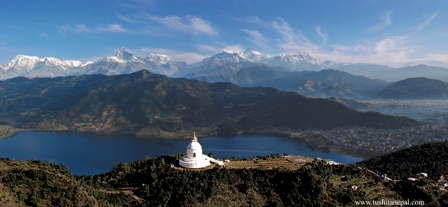POKHARA (Valley of Enchanting Beauty)
In 1899 Ekai Kawaguchi, the Japanese scholar who was the first foreigner to visit Pokhara said, “ … in all travels in the Himalayas I saw no scenery so enchanting as that which enraptured me at Pokhara.”
It is said “If there is a paradise on earth, it begins from north to Pokhara.” Obviously, on the lap of Annapurna Himalayan range, Pokhara is blanketed with emerald blue lakes, lush green forest, deep gorges, underground water falls, caves, hills and rills. This is the only place in the world from where you can see 3 mountains above 800m standing at the elevation of 800m from the sea level. And, Virgin Mt. Fishtail (Machhapuchhre 6993m) is just 21 km away. If Kathmandu is the cultural hub- Pokhara, a place of exhilarating beauty is to refresh- relax and to discover the mysterious creation of nature.
Attractions: Magnificent Annapurna range, Lake Fewa, Sarangkot for sunrise and Mountain View, Tushita-Nepal (meditation center) on the ridge of World Peace Stupa is the best hiking trail for Mountain View and lake view. Paragliding, motor gliding, helicopter charter, natural hot spring, Wild Honey hunting, bicycling, pony ride, visiting astrologers, meditation centers, staying at eco farms. Major city sightseeing are; Davis fall, Gupteshwor cave, Tibetan refugee camp, International mountain museum, cultural museum, Seti gorge, old bazaar, Vindabasini temple, boating at Fewa lake and pay homage in Barahi temple.
KATHMANDU VALLEY (The capital city)
Once upon a time, Kathmandu valley was a big lake. And, according to the legend, the Buddhist lord Manjushree sliced the small hill and drained the water of the lake and made it inhabitable. No doubt, The Newars are the indigenous inhabitants of the valley and the creators of the splendid civilization of its three cities- Kathmandu, Patan and Bhaktapur. Their art and architecture are of sheer magic that one stares for hours. Consequently, UNESCO has declared a world heritage sites to Kathmandu Durbar Square, Patan Durbar Square, Bhaktapur Durbar Square, Pashupatinath Temple, Boudhanath Stupa and Swyambhunath.
The profound religious culture based on a unique amalgamation of Hinduism and Buddhism is very interesting. Multi roofed temples, exquisite monasteries, stone carvings and wooden carvings, and the age-old traditions and religious festivals have kept Kathmandu valley with immense vivacity till today.
Attractions: Sightseeing world heritage sites; Pashupatinath, Boudhanath, Swoyambhunath, Durbar Square, Living Goddess Kumari, shopping at Thamel and Ason area, observing art and architecture, visiting discotheque and casino, Everest Mountain Flight, Meditation centers.
Sightseeing at Patan Durbar Square (city of fine arts): Patan museum, Krishna mandir, Mahabouddha, Hiranya Varna Mahavihar, Kumbheshwor, Jagatnarayan temple, Rudra Varna mahavihar, Temple of Machindranath, Patan industrial estate, central zoo etc.
Bhaktapur (City of devotees): The palace of 55 windows at Durbar Square, Golden gate, Batsala Devi, The National Art Gallery, Nyatpola temple, Bhairavnath temple, Dattatraya temple etc.
LUMBINI (The Birthplace of Lord Buddha)
Situated on the foothills of the Churiya range of Nepal in the district of Rupandehi, the birthplace of Siddhartha Gautam, the shakya prince and the ultimate Buddha, the enlightened one, is the pilgrimage destination of the world’s millions of Buddhists. It is the pilgrimage site for all who cherish peace and harmony. UNESCO listed the nativity site and the Ashoka’s pillar as the world heritage site in December 1997. The great emperor of India Ashoka had visited holy Lumbini and promised not to involve in wars again. As an evidence, he erected Ashoka pillar describing his visit to pay homage and his magnanimity in reducing taxes. Mayadevi temple, sacred garden and the sacred pond (where queen Mayadevi had taken bath just before giving birth to the Buddha) are the major attractions of Lumbini. It is approximately 280 Km away from Kathmandu. Lumbini Development Trust (LDT) is the responsible authority for its development and preservation.
The holy site of Lumbini is bordered by a large monastic zone, in which only monasteries can be built, no shops or hotel or restaurants. It is separated into an eastern and western monastic zone; the eastern having the Theravada monasteries and the western having Mahayana and Vajrayana monasteries. Silently flickering Peepal tree and prayer flags, birds chirping and reflection of gently burning oil lamps on the pond creates peaceful environment. Early morning to late evening pilgrim from various country perform chanting and meditation. The twilight moment is very much peaceful, enchanting and touchy.
In 1896, Nepalese archaeologist team led by Khadga Samsher Rana discovered a great stone pillar at the site attributed to Emperor Ashoka. Records made by the Chinese pilgrim Fa- Xian were also used in the process of identifying this religiously acclaimed site. Despite of crystal clear evidence, construction of duplicate Lumbini in India side has become a shameful act for India government.
Attractions: Lumbini sacred Garden and Bodhi tree, Archeological excavations, Maya Devi temple, Ashoka Pillar, Eternal flame, Monastic zone and Stupas, New Lumbini village, Devdaha and Ramgram




cheap cialis pills – canadian generic cialis no preion needed canadian pharmacy
cialis 50 mg for sale – where to buy cialis buy generic cialis with paypal
ivermectin 12 mg – ivermectin lice oral ivermectin 18mg
casino slot – free casino games golden nugget online casino